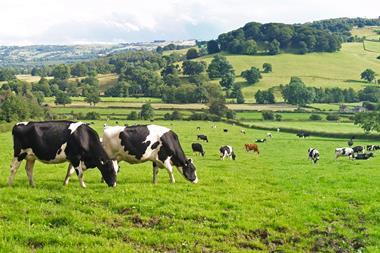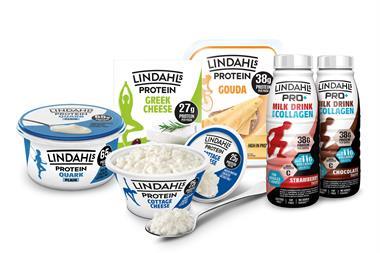Six years on from a major industry investigation, milk producers and processors are still locked in battle over milk prices, in spite of retail initiatives to increase the price in-store. Chris Walkland reports
Who would have predicted that the milk industry would end up here: where the bottom of the market is not set by end-product prices or supply and demand, but by angry, picketing farmers and economically illogical but necessary retail initiatives?
It was meant to be very different after the Monopolies and Mergers Commission’s investigation into Milk Marque and milk pricing exploded at the heart of the dairy industry six years ago this month.
Scattered throughout the MMC report, two words, “behavioural remedies”, described what was needed in relation to Milk Marque.
But, as cited recently on the industry web site milkprices.com: “Thursday night (July 1) saw Farmers For Action stage the largest number of blockades seen in one night for many years. Not since the early days of FFA in 2000 has action and support been seen on such a scale.”
Six years on from the MMC report, it seems behavioural remedies are still required.
Last year’s price turbulence illustrates how bad things have got. The situation reached a nadir this June, when Arla Foods cut its price by 0.35ppl, saying this was justified because it had not cut its price last autumn in line with its competitors.
No one else saw it that way, however. Cue a massive farmer backlash. So, where to from here?
Arla may have generated “incalculable” bad press and feeling with its price cuts, according to quota broker and industry commentator Ian Potter, but it stands by the decision.
Peter Walker, Arla’s director of milk buying, argues: “The price reduction Arla announced to take effect from June 1 was, albeit six months late, the last of a series of industry cuts which began last year. The other direct buyers - Robert Wiseman Dairies and Dairy Crest - made two cuts in their price during 2004 and Arla only one. Other buyers have used this latest decrease as a trigger for further cuts, which is not our business.”
If Arla is bearing the brunt of the backlash, it is important to remember this is an industry problem. There are a number of initiatives currently under way.
The Food Chain Centre is poised to publish a report based on a value chain analysis of the dairy supply chain, an exercise it has already carried out with some success in the meat sector.
If farmers, processors and retailers can strip more costs out of their businesses, then pressures might ease slightly, though it is hard to see this becoming a panacea for the sector’s ills.
Meanwhile, Lord Bach, parliamentary secretary (Lords) for sustainable farming and food, has pledged to “look with fresh eyes” at the problems in the dairy supply chain (although privately industry insiders are wondering why he thinks he will find a solution to these problems when others before him have failed).
There are constructive suggestions for change being put forward. The Royal Association of British Dairy Farmers wants an ‘Ofmilk’ organisation, while FFA wants a single milk-selling agency.
Meanwhile, Dairy Crest commerical director Mark Taylor has proposed that raw milk prices should be calculated according to what the milk is subsequently turned into.
The idea is understood to have interested senior figures in the industry, as well as government officials, but it would seem we are still a long way off seeing what would amount to a revolution in milk pricing. What might at least help would be verification of retail price initiatives, so that when prices rise, an independent body could check that those supposed to receive the extra cash did so.
But who would administer it? Dairy UK, which is funded by processors? The Milk Development Council, which is funded by farmers? It’s another initiative that would need consensus from all in the supply chain, and this is a currency in short supply.
Meanwhile, FFA is continuing to put pressure on Arla to reverse its 0.35ppl cut, says its leader David Handley. If it succeeds,Robert Wiseman will probably rescind its cut and Dairy Crest, and the co-ops, will breathe a sigh of relief. For now.
FFA is concerned that Arla has given away virtually all its margins to the retailers in return for market share, and will be forced to issue a profit warning unless it can cut its farmer price in the future. Arla denies this, saying new efficiencies within the business mean that it can withstand retailer pressures.
In the long term, things will have to change for the better. Processors will have to be able to cut prices where it is justified without facing the wrath of the industry, while farmers will have to be able to press for a sustainable, profitable price to secure income and livelihoods.
Greater transparency is one thing all parties would like to see and to that end some inroads are being made. Robert Wiseman says it has always shared as much information with Wiseman Milk Partnership representatives as it is commercially able, and is sharing more with First Milk as its relationship strengthens.Dairy Crest says the same for its direct suppliers, while Arla emphasises its links with suppliers through the expanding Arla Foods Milk Partnership.
The trouble is that those outside such direct supply groups see them as too close to the companies for comfort.
Independent verification might not be able to work miracles, but it could help. And six years on from the supposed watershed of the MMC report, when it comes to determining milk prices in a calm, rational way, the industry still needs all the help it can get.
>>p68 Arla ups supply from milk partnership
Who would have predicted that the milk industry would end up here: where the bottom of the market is not set by end-product prices or supply and demand, but by angry, picketing farmers and economically illogical but necessary retail initiatives?
It was meant to be very different after the Monopolies and Mergers Commission’s investigation into Milk Marque and milk pricing exploded at the heart of the dairy industry six years ago this month.
Scattered throughout the MMC report, two words, “behavioural remedies”, described what was needed in relation to Milk Marque.
But, as cited recently on the industry web site milkprices.com: “Thursday night (July 1) saw Farmers For Action stage the largest number of blockades seen in one night for many years. Not since the early days of FFA in 2000 has action and support been seen on such a scale.”
Six years on from the MMC report, it seems behavioural remedies are still required.
Last year’s price turbulence illustrates how bad things have got. The situation reached a nadir this June, when Arla Foods cut its price by 0.35ppl, saying this was justified because it had not cut its price last autumn in line with its competitors.
No one else saw it that way, however. Cue a massive farmer backlash. So, where to from here?
Arla may have generated “incalculable” bad press and feeling with its price cuts, according to quota broker and industry commentator Ian Potter, but it stands by the decision.
Peter Walker, Arla’s director of milk buying, argues: “The price reduction Arla announced to take effect from June 1 was, albeit six months late, the last of a series of industry cuts which began last year. The other direct buyers - Robert Wiseman Dairies and Dairy Crest - made two cuts in their price during 2004 and Arla only one. Other buyers have used this latest decrease as a trigger for further cuts, which is not our business.”
If Arla is bearing the brunt of the backlash, it is important to remember this is an industry problem. There are a number of initiatives currently under way.
The Food Chain Centre is poised to publish a report based on a value chain analysis of the dairy supply chain, an exercise it has already carried out with some success in the meat sector.
If farmers, processors and retailers can strip more costs out of their businesses, then pressures might ease slightly, though it is hard to see this becoming a panacea for the sector’s ills.
Meanwhile, Lord Bach, parliamentary secretary (Lords) for sustainable farming and food, has pledged to “look with fresh eyes” at the problems in the dairy supply chain (although privately industry insiders are wondering why he thinks he will find a solution to these problems when others before him have failed).
There are constructive suggestions for change being put forward. The Royal Association of British Dairy Farmers wants an ‘Ofmilk’ organisation, while FFA wants a single milk-selling agency.
Meanwhile, Dairy Crest commerical director Mark Taylor has proposed that raw milk prices should be calculated according to what the milk is subsequently turned into.
The idea is understood to have interested senior figures in the industry, as well as government officials, but it would seem we are still a long way off seeing what would amount to a revolution in milk pricing. What might at least help would be verification of retail price initiatives, so that when prices rise, an independent body could check that those supposed to receive the extra cash did so.
But who would administer it? Dairy UK, which is funded by processors? The Milk Development Council, which is funded by farmers? It’s another initiative that would need consensus from all in the supply chain, and this is a currency in short supply.
Meanwhile, FFA is continuing to put pressure on Arla to reverse its 0.35ppl cut, says its leader David Handley. If it succeeds,Robert Wiseman will probably rescind its cut and Dairy Crest, and the co-ops, will breathe a sigh of relief. For now.
FFA is concerned that Arla has given away virtually all its margins to the retailers in return for market share, and will be forced to issue a profit warning unless it can cut its farmer price in the future. Arla denies this, saying new efficiencies within the business mean that it can withstand retailer pressures.
In the long term, things will have to change for the better. Processors will have to be able to cut prices where it is justified without facing the wrath of the industry, while farmers will have to be able to press for a sustainable, profitable price to secure income and livelihoods.
Greater transparency is one thing all parties would like to see and to that end some inroads are being made. Robert Wiseman says it has always shared as much information with Wiseman Milk Partnership representatives as it is commercially able, and is sharing more with First Milk as its relationship strengthens.Dairy Crest says the same for its direct suppliers, while Arla emphasises its links with suppliers through the expanding Arla Foods Milk Partnership.
The trouble is that those outside such direct supply groups see them as too close to the companies for comfort.
Independent verification might not be able to work miracles, but it could help. And six years on from the supposed watershed of the MMC report, when it comes to determining milk prices in a calm, rational way, the industry still needs all the help it can get.
>>p68 Arla ups supply from milk partnership


















No comments yet